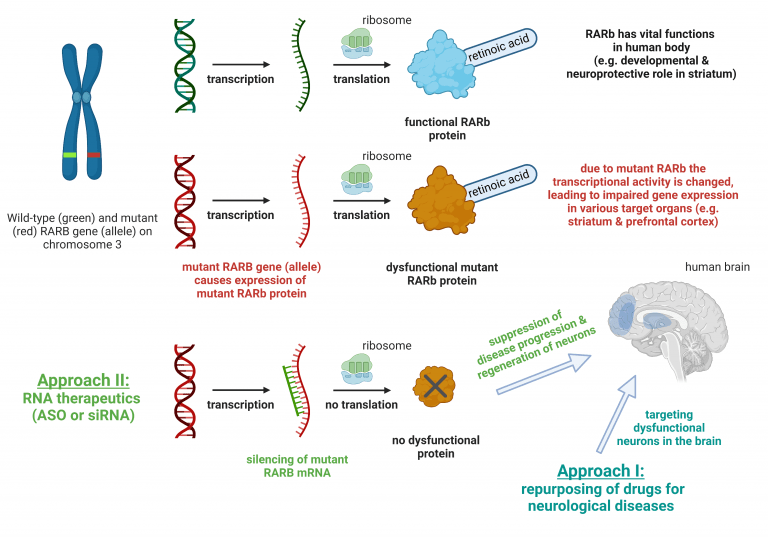Path to Treatment
Background
MCOPS12 is an ultra-rare genetic and complex neurological disease. Common symptoms are developmental disorders of the eye (e.g. microphthalmia), hypotonia (low muscle tone), severe movement disorders and variable cognitive impairment. The movement disorders are progressive and often include dystonia (involuntary muscle contractions) and spasticity. The cognitive impairments show a broad range of symptoms and severity within the patient population.
MCOPS12 is usually caused by autosomal dominant variants in the gene coding for the retinoic acid receptor beta (RARb) protein. “Autosomal” means that the gene in question is located on one of the numbered (non-sex) chromosomes. “Dominant” means that a single copy of the mutated gene is enough to cause the disease.
In the context of MCOPS12 it follows that the mutated copy (allele) of the RARB gene transcribes a mutated mRNA followed by translation to the mutant RARb in the ribosome, whereas the wild-type/non-mutated RARB allele is still coding for a functional RARb protein.
Thus, two different versions of RARb are existing in MCOPS12 patient cells: The mutant version of the protein leading to the imbalanced (gain-of-function or dominant-negative) RARb transcriptional activity causing the disease symptoms (phenotypes), and the “healthy” (non-mutant) protein which has a vital function for the organism (e.g. in the postnatal development and neuroprotection of the striatum). These findings are very important because they enable the development of allele-specific RNA therapeutics to “silence” (knock-down) the mutant mRNA and thus combat the disease at its genetic level, while maintaining the vital function of the non-mutant RARb.
Two Paths to Treatment
Cure MCOPS12 has elaborated two paths to treatment for MCOPS12 in close collaboration with the academic research teams and with help by scientifc advisers from pharmaceutical industry:
The first path aims at treating the movement disorders and cognitive impairments in MCOPS12 children by applying a drug repurposing approach. Drug repurposing is the process of investigating new therapeutic purposes for already existing drugs. It is a powerful tool especially for rare disease therapy development since the mechanism and potential adverse effects of the applied drugs are already known. Six drugs, which are commercially available or in clinical trials for other neurological diseases, are tested in a MCOPS12 mouse model to find treatments for hypotonia, dystonia and (to a certain degree) for the cognitive impairments related to MCOPS12.
The second path focuses on the development of a RNA therapeutic, such as an antisense oligonucleotide (ASO) or small interfering RNA (siRNA), to silence the mutant RARB mRNA in order to suppress translation (biosynthesis) of the mutant RARb protein in MCOPS12 patients. RNA therapeutics are still a new but very promising tool to cure genetic diseases. Compared to gene therapies and gene-editing therapies, which adress the DNA of a patient and are considered one-time and irreversible treatments, ASO and siRNA therapeutics interfere with RNA and thus are reversible but also require repetitive administration.

Figure 1: Approaches for treatment of movement disorders and cognitive impairment in MCOPS12 patients

